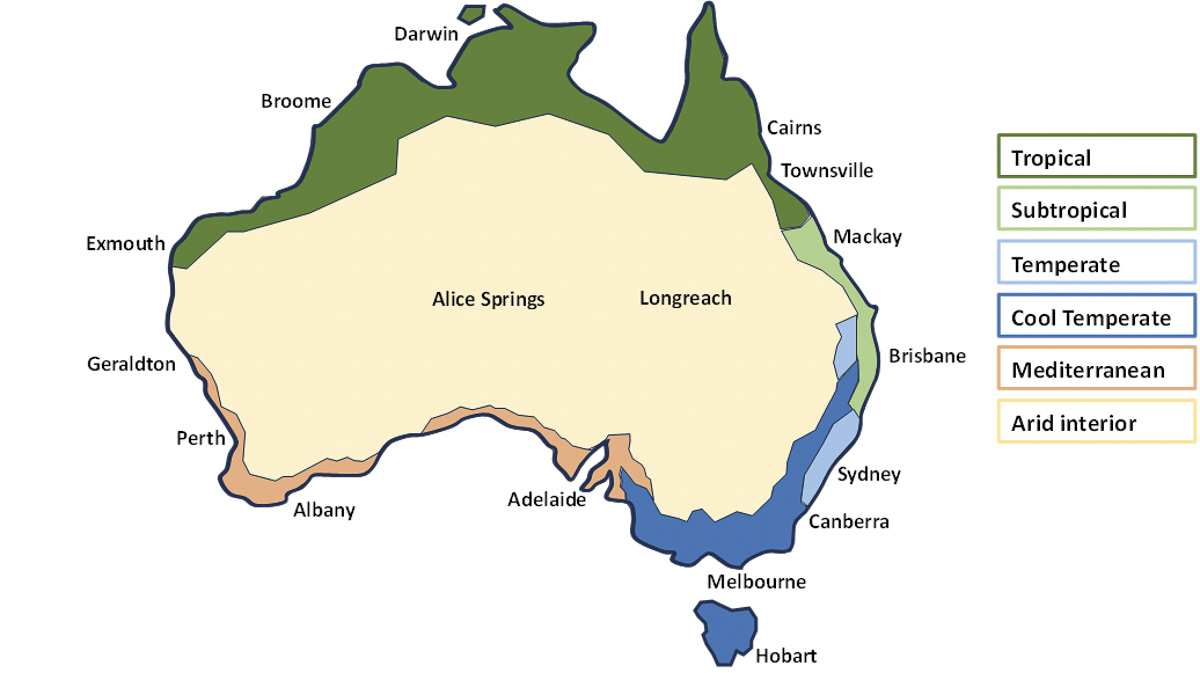When embarking on native garden design, be sure to consider the regional climate and microclimate. This improves your chances of success. This article outlines the major regional climates, as well as how to identify the microclimates in your garden.
Regional climate
Australia, the world’s largest and driest island continent, has a diverse range of regional climates. These are generally simplified into six regions.

Regional climate | Characteristics | Example locations |
Tropical – wet tropics and monsoon tropics | High humidity with most rainfall in summer, and warm dry winters | Cairns, Townsville, Darwin, Broom, Exmouth |
Subtropical | Warm humid summers with high summer rainfall, and mild dry winters | Mackay, Rockhampton, Bundaberg, Hervey Bay, Sunshine Coast, Brisbane, Gold Coast, Coffs Harbour |
Temperate – wet winter or annually uniform | Moderate humidity and reliable uniform rainfall, with four distinct seasons | Toowoomba, Newcastle, Central Coast NSW, Sydney, Wollongong |
Cool Temperate – coastal or montane | Low humidity with most rainfall in winter; hot dry summers and cold winters. Some frosts and snow | Great Divide tablelands, Canberra, Melbourne, Ballarat, Bendigo, Geelong, Launceston, Hobart, Mt Gambier |
Mediterranean – wet winter & dry summer | Warm wet winter and hot dry summer, two distinct seasons | Adelaide, Port Lincoln, Esperance, Albany, Perth, Geraldton |
Arid interior | Hot dry summers, winters can be warm or cool depending on the region | Alice Springs, Mildura, Albury-Wodonga, Shepparton, Wagga Wagga, Dubbo |
Microclimates
Within each of these diverse Australian climatic regions, local site conditions dictate the site-specific microclimates. These are a major factor that influence the physical characteristics, the planning and design, and ongoing establishment of any garden.
Understanding seasonal patterns of sunshine and shadow and using them as design tools is fundamental in garden layout and establishment. Before commencing garden design, have you considered preparing a sunshine and shadow analysis drawing of the site? See our story here on how to do that.
Knowing how sunshine and shadow impacts your garden is the major factor to define the overall landscape planning and design. It also helps determine the choice for the plant species and the landscape materials.
These are four of the more important questions:
- Do you choose and locate plants according to their tolerance of the specific microclimate (sun and shade) of each area?
- Is the knowledge of microclimate patterns foremost in your mind when selecting species for seasonal flower or foliage effect?
- Do you know which areas of the garden receive full sun in winter mornings and where there is breezy, cool shade in summer afternoons? This helps plan the optimum location for each outdoor living area.
- Can you determine the ideal location for a shade tree? This enables you to control where it provides shade in summer, and sunshine in winter.
These and many other questions about microclimate are covered in the following discussions about climate and microclimate.
Be sure to consider regional climate and microclimate in your native garden design. This includes doing a sunshine and shade patthern analysis.
These steps will help ensure your design and planting best fit your site.


Other stories in this series on microclimates:
 Australian Native Plants Society (Australia)
Australian Native Plants Society (Australia)